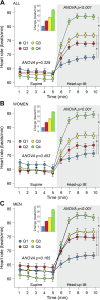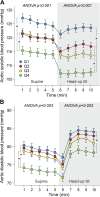Differences in heart rate responses to upright posture are associated with variations in the high-frequency power of heart rate variability
- PMID: 38133619
- PMCID: PMC11219049
- DOI: 10.1152/ajpheart.00567.2023
Differences in heart rate responses to upright posture are associated with variations in the high-frequency power of heart rate variability
Abstract
High resting heart rate is a cardiovascular risk factor, but limited data exist on the underlying hemodynamics and reproducibility of supine-to-upright increase in heart rate. We recorded noninvasive hemodynamics in 574 volunteers [age, 44.9 yr; body mass index (BMI), 26.4 kg/m2; 49% male] during passive head-up tilt (HUT) using whole body impedance cardiography and radial artery tonometry. Heart rate regulation was evaluated using heart rate variability (HRV) analyses. Comparisons were made between quartiles of supine-to-upright heart rate changes, in which heart rate at rest ranged 62.6-64.8 beats/min (P = 0.285). The average upright increases in heart rate in the quartiles 1-4 were 4.7, 9.9, 13.5, and 21.0 beats/min, respectively (P < 0.0001). No differences were observed in the low-frequency power of HRV, whether in the supine or upright position, or in the high-frequency power of HRV in the supine position. Upright high-frequency power of HRV was highest in quartile 1 with lowest upright heart rate and lowest in quartile 4 with highest upright heart rate. Mean systolic blood pressure before and during HUT (126 vs. 108 mmHg) and the increase in systemic vascular resistance during HUT (650 vs. 173 dyn·s/cm5/m2) were highest in quartile 1 and lowest in quartile 4. The increases in heart rate during HUT on three separate occasions several weeks apart were highly reproducible (r = 0.682) among 215 participants. To conclude, supine-to-upright increase in heart rate is a reproducible phenotype with underlying differences in the modulation of cardiac parasympathetic tone and systemic vascular resistance. As heart rate at rest influences prognosis, future research should elucidate the prognostic significance of these phenotypic differences.NEW & NOTEWORTHY Subjects with similar supine heart rates are characterized by variable increases in heart rate during upright posture. Individual heart rate increases in response to upright posture are highly reproducible as hemodynamic phenotypes and present underlying differences in the modulation of cardiac parasympathetic tone and systemic vascular resistance. These results indicate that resting heart rate obtained in the supine position alone is not an optimal means of classifying people into groups with differences in cardiovascular function.
Keywords: head-up tilt; heart rate; phenotype.
Conflict of interest statement
No conflicts of interest, financial or otherwise, are declared by the authors.
Figures





References
-
- Stergiou GS, Palatini P, Parati G, O'Brien E, Januszewicz A, Lurbe E, Persu A, Mancia G, Kreutz R; European Society of Hypertension Council and the European Society of Hypertension Working Group on Blood Pressure Monitoring and Cardiovascular Variability. 2021 European Society of Hypertension practice guidelines for office and out-of-office blood pressure measurement. J Hypertens 39: 1293–1302, 2021. doi:10.1097/HJH.0000000000002843. - DOI - PubMed
-
- Friedman GD, Klatsky AL, Siegelaub AB. Predictors of sudden cardiac death. Circulation 52: III164–III169, 1975. - PubMed
Publication types
MeSH terms
Grants and funding
- Sydäntutkimussäätiö (Finnish Foundation for Cardiovascular Research)
- Sigrid Juséliuksen Säätiö (Sigrid Jusélius Stiftelse)
- 9AB057/Competitive State Research Financing of the Expert Responsibility Area of Tampere University Hospital
- 9AC076/Competitive State Research Financing of the Expert Responsibility Area of Tampere University Hospital
- Päivikki and Sakari Sohlberg Foundation
LinkOut - more resources
Full Text Sources
Medical
Research Materials

